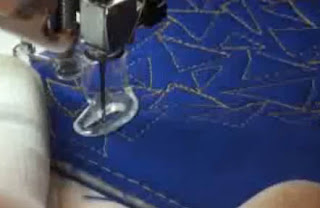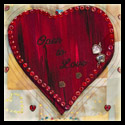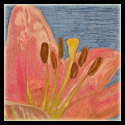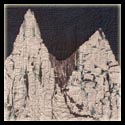I spent the day literally dyeing to embroider… yes, I am anxiously awaiting getting down to stitching, but I mean “dyeing” with an “e” in it. Rather than using all commercially available embroidery floss, we spent the day making our own threads, for the first of 5 days in “Experimental Hand Stitch” at the Gail Harker Center for the Creative Arts in LaConner, WA. I’ve always salivated at the yummy colors of hand-dyed threads. Now I know how to make them!
First, we had to prepare the skeins of thread. There are two main types of embroidery thread, pearl (or perle in French) cotton which is a twisted cotton and cotton floss (also known as 6-stranded cotton.) Pearl cotton comes in many different thicknesses: 3, 5, 8, 12, and 16, with 3 being the thickest and 16 being quite delicate. Six-stranded cotton is literally that, 6 strands that you can separate, depending upon how thick a piece you want for your project. Of course there are many other types of threads or yarns you can use for embroidery and any natural fiber will work for dyeing (silk, rayon, bamboo, etc.) We have several unusual yarns and threads as well as the pearl cotton and cotton floss.

To prepare for dyeing, we had to get the thread into skeins (some of it came on balls or rolls that we had to wind into a skein) and then tie the skeins about every 12 inches (30 cm), to make sure it wouldn’t get tangled up. We used a figure 8 tie with a square knot, tight enough to hold the skein in place, but not so tight that it would cause a resist and have the thread not take up the dye underneath the tie.
As with any Procion MX dyeing, we then soaked our threads in a soda ash solution, so that the chemical bond would occur in the fiber when the dye is introduced.
 The next step was to use a syringe to “paint” the colors on the thread. As you inject the dye onto the thread, you then need to smoosh it down to ensure that it is completely saturated, particularly wherever the ties are. I chose to mainly go with an analogous color scheme from yellow-green, to green, to blue-green, to blue, to blue-violet, to violet. With sticking to one color scheme, I can be assured that my projects using these dyed threads will go together.
The next step was to use a syringe to “paint” the colors on the thread. As you inject the dye onto the thread, you then need to smoosh it down to ensure that it is completely saturated, particularly wherever the ties are. I chose to mainly go with an analogous color scheme from yellow-green, to green, to blue-green, to blue, to blue-violet, to violet. With sticking to one color scheme, I can be assured that my projects using these dyed threads will go together.
When all the dye is on the threads, you carefully roll the threads up in plastic (see red arrow) and then leave it overnight to process. I can’t wait to see them in the morning!
 |
My Mom, Nan Lopis, working
on her dyed threads |
The best thing of all… my Mom has joined me for the 5 day class at Gail Harker’s! I was concerned that the dyeing might not be something she’d enjoy (she’ll love the hand-stitching), but she came through like a champ, and made a lovely yellow-olive-greens colorway of threads.
Note: all the threads in the photos above have wet dye on them. The colors will change somewhat upon the dye setting and washing them afterwards. One of my favorite parts of dyeing is when you unwrap it the next day and wash it out… it’s like getting a present!
You Might Also Be Interested in:














































































